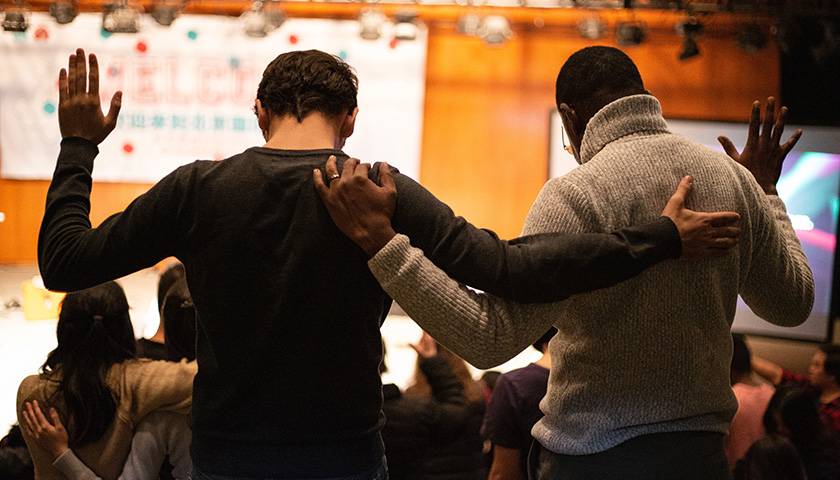by Stephen Whitney
America is a diverse country. In most cities, you can find people from nearly every ethnic or racial background imaginable. This is becoming the case in rural areas as well. But America is host to a considerable amount of religious diversity as well. And while race relations are often the subject of considerable discussion, understanding interreligious relations is a necessary part of understanding the country as a whole.
A Pew Research paper published earlier this month offers a fascinating look at how the main religious groups in America view one another. Titled “Americans Feel More Positive Than Negative About Jews, Mainline Protestants, Catholics,” the study surveyed the feelings of 10,588 Americans toward members of other religious backgrounds.
Some religious groups were overall viewed more favorably than unfavorably: Jews, mainline Protestants, Catholics, and evangelical Christians. On the other hand, unfavorable replies outnumbered favorable ones for atheists, Muslims, and Mormons. Worth noting, however, is that most respondents in this instance replied that they had neither a favorable nor unfavorable view of the group in question or that they didn’t know enough to say. For example, 35 percent of respondents have a very or somewhat favorable opinion of Jews, with just 6 percent having a very or somewhat unfavorable opinion of them. Yet 58 percent responded in the aforementioned neutral manner. Such was the case for other groups as well to varying degrees.
Why is this the case? “Some survey respondents may find it strange or difficult to be asked to rate an entire group of people,” writes Patricia Tevington, the study’s author. “Indeed, most Americans give a neutral response – or choose not to answer the question – when asked about some religious groups.”
Tevington points out that “the patterns are affected in part by the size of the groups asked about, since people tend to rate their own religious group positively.” To account for this, the study also asked respondents about their feelings toward religious groups other than their own and examined the data when not including how participants rated their own groups. Some groups were affected less than others. For instance, even when only non-Jewish respondents were asked about Jews, far more responded favorably than unfavorably.
It’s a different story with evangelicals: 28 percent of respondents overall view evangelical Christians favorably, narrowly surpassing the 27 percent who view them unfavorably. But when non-evangelicals were asked how they felt about this group, the response was considerably less positive: 18 percent favorable and 32 percent unfavorable.
As Tevington notes, there is likely a political dynamic at play here. “Some of this sentiment is tied up with politics,” she writes. “Democrats who are not born-again or evangelical Protestants are far more likely than non-evangelical Republicans to view evangelicals negatively (47% vs. 14%, respectively).”
Put another way, many Americans appear to associate evangelicals with Republicans. Such an association isn’t baseless: 56 percent of evangelicals say they are Republican or lean Republican, and among white evangelicals who regularly go to church, 85 percent voted for Trump in 2020.
On the other hand, “Americans overall also express more favorable than unfavorable attitudes toward mainline Protestants (30% favorable vs. 10% unfavorable) and Catholics (34% favorable vs. 18% unfavorable).”
Of all groups included in the study, Mormons were defined by the greatest disparity between their perception of other groups and how those groups perceive them. Tevington writes, “A quarter of Americans say they hold very or somewhat unfavorable views of Mormons, while 15% express favorable opinions.” This negativity was not reciprocated, however. Of all groups, Mormons are the only that “do not express a net negative opinion toward any group in the survey, and are strongly positive toward several.” In fact, Mormons are so positive toward other groups that they are the only religious group to view Muslims favorably (47 percent favorable and 11 percent unfavorable).
The data regarding atheists are particularly interesting:
“Jews are the only religious group who receive a positive rating, on balance, from atheists (+13 percentage points), aside from atheists’ ratings of their own group. Jews also are more likely to express positive than negative views toward atheists. By contrast, atheists feel overwhelmingly negative toward evangelical Christians (79% express unfavorable views, compared with 3% who express positive views). Atheists also are more negative than positive toward Catholics, mainline Protestants, Mormons and Muslims. The negative feelings are mutual when it comes to Protestants and Catholics, who give atheists net negative ratings.”
It would appear that, despite an ongoing trend toward secularization in America, atheists are still viewed askance by most religious groups. But as the data show, the feeling is mostly mutual.
There’s much to glean from this report. But one thing is clear: America boasts considerable religious diversity, and the relationships between its religious groups are highly complex. America was once a nearly exclusively Protestant country. That is no longer the case. As such, regardless of our religious backgrounds or political affiliations, we stand much to gain from understanding the various religious divides in America—and how political polarization affects the way we see one another’s faiths.
– – –
Stephen Whitney is a contributor to Intellectual Takeout.
Photo “People at Church” by Sam Balye.




